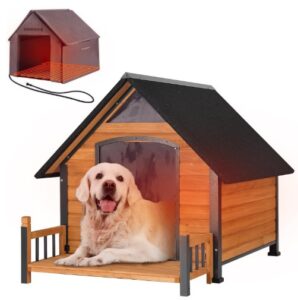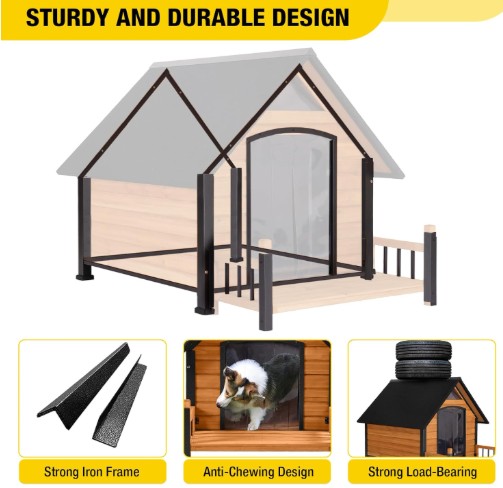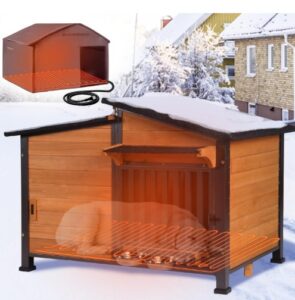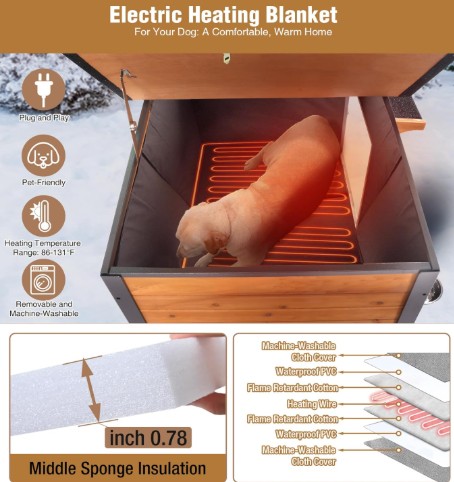Last Updated on 02/10/2025 by Liza Brits
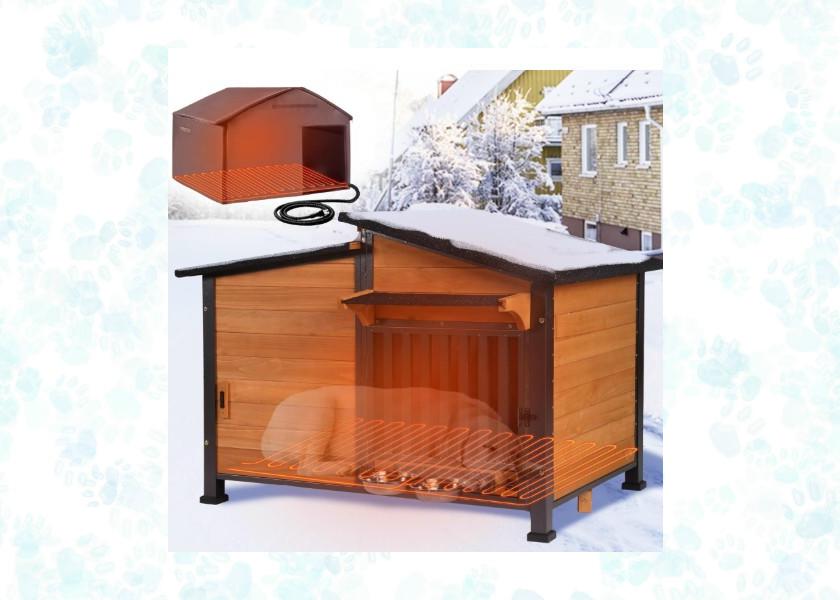
Disclosure
We share trusted product recommendations through affiliate partnerships with leading brands. This means when you find something you love and purchase through our links, we may earn a small commission (at no extra cost to you.) It’s our way of keeping the lights on while helping you discover the best smart pet tech products. 🐶😺
As the days get shorter and the temperatures drop, many of us are bundling up and cranking up the heat indoors. But what about our beloved canine companions who spend time outside? While some breeds are built for colder weather, even they can benefit from a little extra warmth when the chill truly sets in. That’s where a heated dog house comes in!
More than just a fancy accessory, a heated dog house can be a game-changer for your dog’s comfort, health, and overall well-being. Let’s dive into why this investment might be the best one you make for your furry friend this winter.
🌠The Benefits of a Heated Dog House: Beyond Just Being Cozy
1. Protection Against the Elements: The most obvious benefit is protection from cold, wind, and dampness. A well-insulated and heated dog house provides a crucial refuge, preventing your dog from having to brave harsh winter conditions. This is especially important for”
- Short-haired breeds: Dogs with less fur simply don’t have the natural insulation to stay warm in freezing temperatures.
- Senior dogs: Older dogs are more susceptible to the cold and can experience increased joint pain and discomfort.
- Dogs with health conditions: Certain illnesses can make a dog more vulnerable to the cold.
- Any dog spending extended time outdoors: Even hardy breeds need a warm spot when temperatures plummet.
2. Improved Health and Well-being: Exposure to extreme cold can lead to serious health issues, including:
- Hypothermia: A dangerous drop in body temperature.
- Frostbite: Damage to skin and tissue, especially on ears, paws, and tail.
- Aggravated Arthritis and Joint Pain: Cold weather can exacerbate existing joint problems, causing discomfort and stiffness. A warm environment can help soothe these aches.
- Weakened Immune System: Chronic exposure to cold can stress your dog’s system, making them more vulnerable to illness.
3. Enhanced Comfort and Rest: Just like us, dogs sleep better when they are comfortable. A heated dog house provides a snug, warm environment where your dog can truly relax and get restorative sleep, leading to a happier, healthier pet.
4. Peace of Mind for Pet Parents: Knowing your dog is warm and safe while you’re away or asleep can provide immense peace of mind. You won’t have to worry about them shivering in the cold, allowing you to relax knowing they are well cared for.
🏆2 Best Heated Dog Houses for Outdoors
- Aivituvin Heated Dog House with Porch
- GUTINNEEN Heated Dog House – ⭐ Our Favorite
1. Aivituvin Heated Dog House with Porch
Key Features
✅Dimensions: 50.8″D x 37.4″W x 37.2″H.
✅Weather-resistant Design: Made with a sturdy iron frame and fir wood for robustness. The air-tight design and sloped asphalt roof prevents water from seeping into the dog house. It also features a porch area for your dog, which provides extra space, and the entrance has a vinyl curtain to eliminate drafts. The raised insulated kennel has waterproof plastic feet.
✅Removable Heating pad: The 0.78″ thick, multi-layered heating pad consists of non-woven fabric, waterproof PVC, waterproof Oxford cloth, and flame-retardant sponge. The heating pad is thermostat controlled, and the wiring is chew-proof.
✅Easy to clean: The removable bottom floors make cleaning convenient and easy.
✅Quick & easy setup: Easy to assemble.
Considerations
❌ Heating pad requires electricity.
Reviews:
“Fantastic, Beautiful, great for your animal, WORTH EVERY PENNY, this will last forever. I was surprised when I received it and put it together. Worth more than what they charge for it. This is a life time home for the pet, BEAUTIFULLY PUT TOGETHER, MY 2 LITTLE dogs will LOVE their new space. So PERFECT FOR THEM. I am thrilled with the purchase, It just doesn’t get better than this. Assembly was easy, instructions were great……”
“Absolutely 100% love this dog house for my dog, I have a German Shepherd, and she has never been happier, well, well more than I expected for the money.”
“This is a well made, sturdy dog house. It took a while to assemble but the parts were clearly marked and the instructions were excellent. I moved it from my porch to the spot I wanted it and it was heavy but not too. I would estimate maybe 60 lbs. It looks great. My dog likes it. I’m happy 🙂“
2. GUTINNEEN AIR7021 Heated Dog House – 🏆Our Favorite
Key Features
✅Dimensions: 25.5″D x 39.7″W x 32.2″H.
✅ Robust Weatherproof Design: Made with a 16mm-wide sturdy iron frame, 100% fir wood with waterproof paint and 5mm metal legs. The sloped asphalt roof prevents water from seeping in and the entrance has a detachable PVC curtain.
✅ Heating pad: The 0.78″ thick heating pad and sponge insulation is removable, which makes it ideal for all-season use. The thermostat-controlled heater’s temperature ranges between 86° – 131°F, depending on the environment.
✅Insulation: A removable 6-sided insulated sponge with polyester fabric and a PVC coating, which is machine washable.
✅Safety: The heating pad is UL and FCC certified and has an automatic shut-off function to prevent overheating. The wiring for the heating pad is chew-resistant.
✅360° Rotating Bowls: Contains 2 x detachable stainless steel bowls on a swing that makes refilling extremely easy and convenient without having to open the door.
✅ Easy to clean: The removable bottom floors make cleaning convenient and easy.
✅ Quick & easy setup: Easy to assemble.
Considerations
❌ Heating pad requires electricity.
Reviews:
“Very heavy duty, so very heavy. Nice materials. Easy to put together. Pretty good instructions. We bought two for our outside ‘stray’ cats.”
“Well built, nice looking, dog loves it. I would buy again.”
“I am sooooooooo thankful y’all delivered this ahead of time before the snow came…we have a stray dog that lives at work who loves her freedom and won’t go home with any of us, she has toughed it out every single winter with very little. This year…..she is warm and happy, you can see it in her eyes she’s so grateful. I didn’t think I’d receive this in time…also, the house is AMAZING. It really does stay warm in very low temps. And it’s so cute. Thank you again!”
👀 What to Look for in a Heated Dog House
When selecting a heated dog house, consider these key features:
- Insulation: Good insulation is crucial to retain heat and keep energy costs down.
- Heating Source: Look for safe, low-wattage heating pads or panels specifically designed for pets. Ensure they have automatic shut-off features or thermostats.
- Durability: The house should be made from sturdy, weather-resistant materials like treated wood or heavy-duty plastic.
- Size: It should be large enough for your dog to stand up, turn around, and lie down comfortably, but not so large that it’s difficult to heat effectively.
- Elevated Floor: An elevated floor helps keep the bottom of the house dry and warmer by preventing direct contact with cold, damp ground.
- Easy to Clean: Removable floors or roofs can make cleaning much easier.
✔️ Making the Right Choice for Your Canine Companion
Investing in a heated dog house is an investment in your dog’s health, comfort, and happiness. It shows them that you care about their well-being, even when they’re enjoying the great outdoors.
Don’t let your best friend shiver through another winter. Explore the options for heated dog houses and give your pup the ultimate cozy retreat they deserve!
❓(FAQs) About Heated Dog Houses
1. Is it safe to leave a heated dog house or pad plugged in 24/7?
Generally, yes, modern, high-quality, pet-specific heated products are designed for continuous 24/7 operation throughout the cold season. Look for products that are certified by recognized electrical safety labs (such as MET or UL). These units, especially dog house heaters, often have a durable, sealed heating element and built-in thermostats that only cycle on when the temperature drops, making them safe and energy-efficient to leave plugged in.
2. Can my dog get burned by the heater or heating pad?
When used correctly, no. Pet-safe heaters and pads are designed to heat to a controlled, moderate temperature. Most pet heating pads are regulated to only warm up to your dog’s natural internal body temperature (around 102∘F) once the dog lies on them. Heating pads have shielded heating elements and thermostats to prevent surface temperatures from becoming dangerously hot. Never use a human heating pad or space heater, as these can get dangerously hot and pose a fire risk in a confined space.
3. What if my dog is a chewer? Are the cords safe?
For chewers, look for products with chew-resistant features. Premium built-in heaters typically use protected wiring that is inaccessible to the dog. Heated pads designed for outdoor kennels often feature steel-wrapped or heavy-duty plastic cords that deter chewing and prevent electrical exposure. Always inspect the cord regularly and ensure the excess slack is secured away from your dog.
4. What is the ideal temperature inside a heated dog house?
The ideal temperature is one that prevents chilling without overheating. For most dogs, keeping the interior air temperature between 50∘F to 60∘F (10∘C to 15∘C) is sufficient for comfort and safety. The USDA mandates that the temperature for sheltered dogs (especially those not acclimated to the cold) should not fall below 50∘F (10∘C) for more than four consecutive hours. The dog should always have enough space to move away from the direct heat source if they get too warm.
5. Is a fully insulated house enough, or do I need a heater?
An insulated house alone is usually sufficient if the temperature rarely drops below freezing (around 32∘F or 0∘C), as insulation effectively traps and retains your dog’s own body heat. However, a heater is necessary if:
- Temperatures frequently drop well below freezing.
- Your dog is a small breed, short-haired, elderly, or has health issues.
- You need guaranteed warmth to meet the required 50∘F minimum.
6. How much does it cost to run a heated dog house or heating pad?
The cost is typically low because pet heaters are highly efficient and only run intermittently. Most high-quality dog house heaters or pads use between 40 and 150 watts (W) of power. A 150W heater running for 10 hours a day costs significantly less than a standard residential space heater (which often uses 1,500W). Look for models with a thermostat for maximum energy savings.
7. What size dog house is best for cold weather?
A dog house should be snug, but large enough for your dog to stand, turn around, and lie down comfortably. Avoid oversized houses in cold weather. A smaller interior volume allows the dog’s body heat (or the heater’s warmth) to be trapped and maintained much more efficiently than a large, empty space.
8. Can I use a heated pad inside an insulated dog house?
Yes, this is an excellent and common combination. A heating pad placed on the floor provides radiant warmth directly to the dog, while the insulation retains that heat. Always use a heated pad that is rated for indoor/outdoor use and ensure the power cord is properly protected from chewing and moisture. Read our article on the best heated pads and pet beds here.
9. What kind of bedding is safest to use with a heater or heating pad?
The safest bedding choices are materials that are low-profile, dry, and not highly combustible. Avoid soft, fluffy blankets or towels, which can easily bunch up and hold moisture, reducing the pad’s effectiveness and posing a slight risk if they contact an unshielded heating element. Dry straw or cedar shavings are natural insulators and are safer to use with heat sources than cloth bedding.
10. Do heated dog houses require special wiring or outlets?
No, most products operate on a standard 120-volt household current. However, for any outdoor electrical application, you must use an outdoor-rated extension cord with a proper gauge, and it must be plugged into a GFCI (Ground-Fault Circuit Interrupter) protected outlet. This crucial safety step prevents electrocution by automatically shutting off the power if a short circuit or water exposure occurs.

